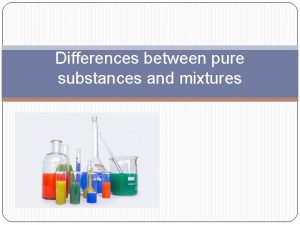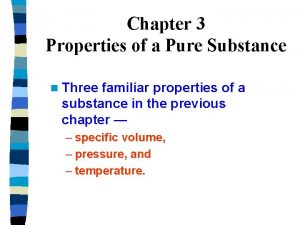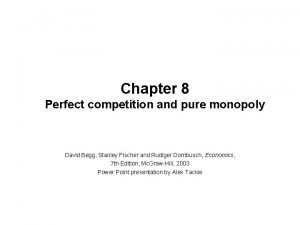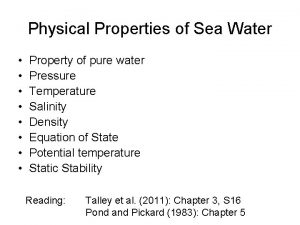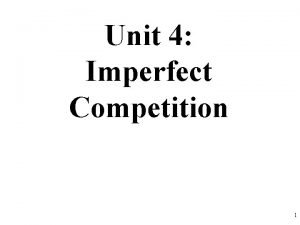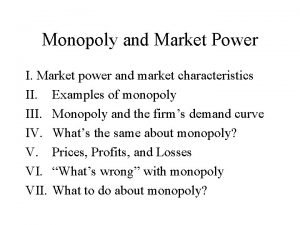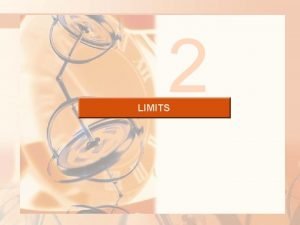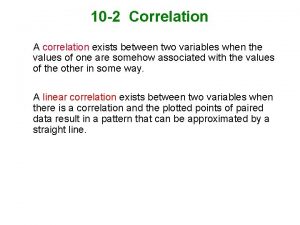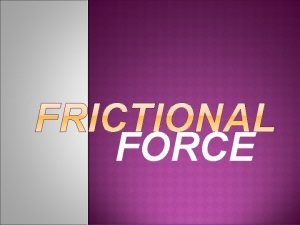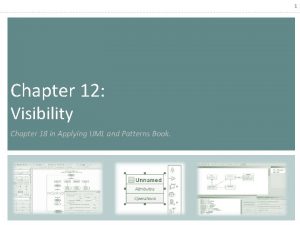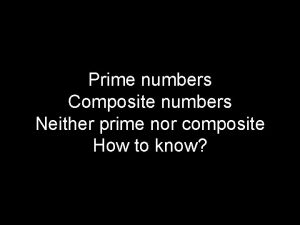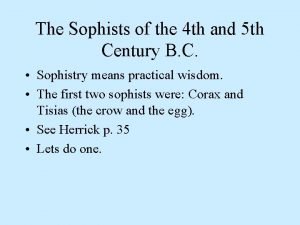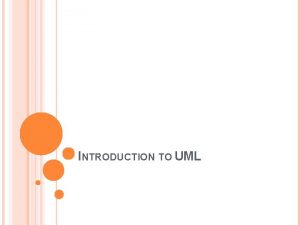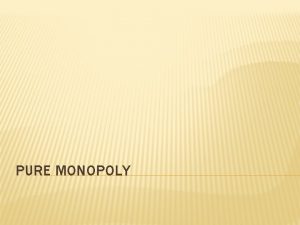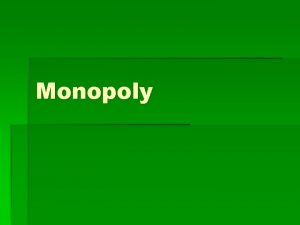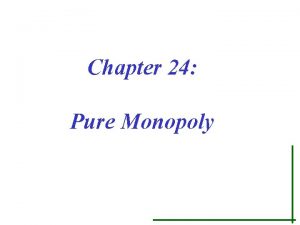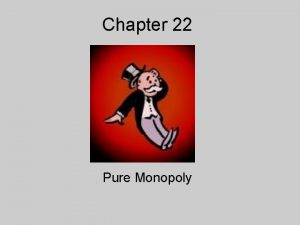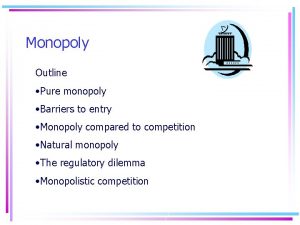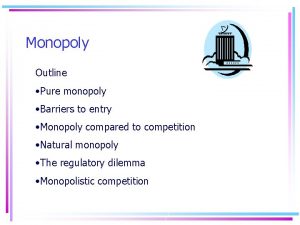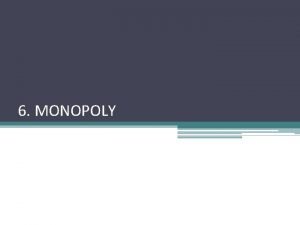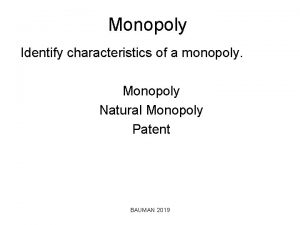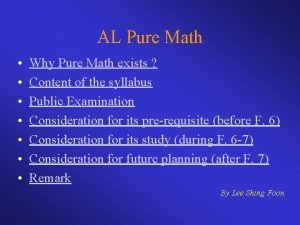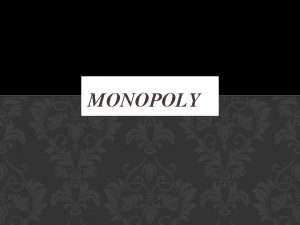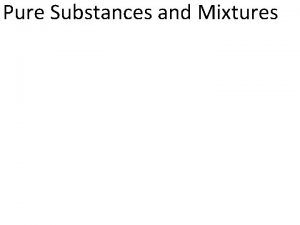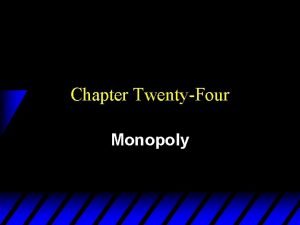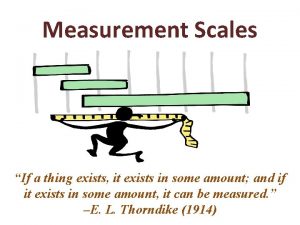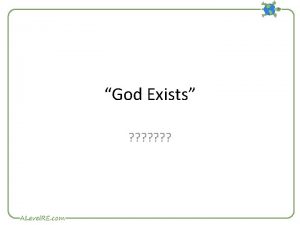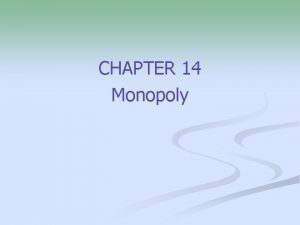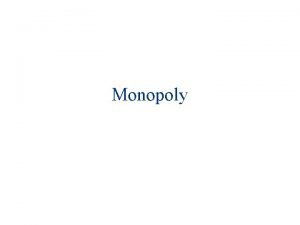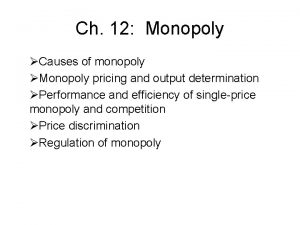Monopoly Characteristics of a Monopoly Pure Monopoly exists



























- Slides: 27

Monopoly

Characteristics of a Monopoly �Pure Monopoly: exists when a single firm is the sole producer of a product for which there are no close substitutes �There are several key characteristics of a monopoly, � 1) Single seller: a monopolist is the sole producer of a specific good � 2) No close substitutes: a pure monopoly’s product is unique in that there are no close substitutes � 3) Price maker: a pure monopolist controls the total quantity supplied and thus has considerable control over price � 4) Blocked entry: a pure monopolist has no immediate competitors because certain barriers keep potential

Barriers to Entry �Barriers to entry: are the factors that prohibit firms from entering an industry. �There are three types of barrier to entry: legal, natural and strategic �Legal barriers to entry: create a legal monopoly, a market in which competition and entry are restricted by, o Granting of a public franchise (e. g. Canada Post) o Government licensing (e. g. a license to practice law or medicine) o Patents and copyrights

�Natural barriers to entry: create a natural monopoly, which is an industry in which one firm can supply the entire market at a lower price than two or more firms can. o A firm is a natural monopoly if it exhibits increasing returns to scale (i. e. has a downward sloping long-run average cost (LRAC) curve) �Pricing and strategic barriers to entry: monopolists may slash prices, step up advertising, or take other strategic action to make it difficult for the entrant to succeed.

Examples of Monopoly �Examples of pure monopolies are relatively rare, but there are many examples of less pure forms o Cable TV companies (Rogers, Cogeco) o Government-regulated public utilities o Intel, provide 80 percent of microprocessors o Pfizer, patents for many pharmaceutical drugs o Professional sports teams, sole suppliers of specific services in large geographic areas

Demand curve for a Monopolist �Unlike a perfect competitor, a monopolist is a price maker �Since it is the sole producer of a product, it faces the market demand curve �That is, a monopolist’s demand curve is downward sloping �Under conditions of monopoly the marginal revenue curve is below the demand curve

Revenues for a Monopolist �A monopolist’s average revenue (AR) curve is the same as the downward-sloping market demand curve �A monopolist’s marginal revenue (MR) curve is also downward sloping but below the market demand curve �Example; Revenue schedules for IBM Price (P) Quantit y (Q) Total Marginal Averag Revenue e e (TR) (MR) Revenu e (AR) Total Cost (TC) Averag e Cost (AC) Marginal Cost (MC) 160 160 140 140 120 2 240 80 120 180 90 40 80 3 240 0 80 249 83 34. 5 40 4 160 -80 40 400 100 75. 5

�We can use the table to graph the marginal revenue and demand curves,

Monopolist- Profit Maximization �Profit-maximizing output rule: says that profit is maximized when the firm produces an output at which MR equals MC. o The MR = MC rule applies to all profit-maximizing firms regardless the market structures

�A monopolist produces an output level at which MR = MC �Hence, the monopolist’s optimal price is PM and optimal output is QM �Since a perfectly competitive firm faces a horizontal demand curve, where P = MR = AR �A perfectly competitive firm produces an output level at which P = MC �Hence, it’s optimal price is PC and optimal output is QC �A monopoly raises revenue by reducing output, relative to the competitive equilibrium, and increasing price �Monopolies do not allocate resources in a way that maximizes welfare and consequently they achieve a level of output that is allocative inefficient o P > MC

Profit Maximization for a Monopolist �A monopolist maximizes profit at the quantity where MR = MC �At this level of output, they charge the highest price possible, as found using the demand curve

�There are there possible cases when determining the profit maximizing output for a monopolist �If P < AC then Profit < 0 (i. e. the firm’s profit is negative) �If P = AC then Profit = 0 (i. e. the firm breaks even) �If P > AC then Profit > 0 (i. e. the firm’s profit is positive) o Supernormal profits can be achieved, and are common, in the long-run Supernormal Profit Negative Profit

Revenue Maximization �In some circumstances a monopoly make seek to maximize revenues, o Total revenue (TR) is maximized when MR = 0 o Monopolists who seek to maximize revenues will sell at lower prices and produce more output. o They will also earn less profit (B + C) than monopoly firms seeking to maximize profits (A + B)

Competition versus Monopoly �As a result of monopoly power, a monopolist charges a higher price and a lower quantity is produced than would occur if the market were perfectly competitive Demand Perfect Competition Monopoly Demand is perfectly elastic, P = MR = AR Demand is downward sloping, P = AR Profit. Produces at an output where P = MR Produces at an output Maximizing = MC level where MR = MC Output Rule �There are two possible scenarios when a monopolist take over the industry �Case 1: No economies of scale are available o The monopolist runs a multi-plant firm with a higher price and lower output than under perfect competition

�Case 2: Substantial economies of scale are present o The price under monopoly may well be lower than under perfect competition (i. e. PM < PPC) o The quantity under monopoly may be greater than under perfect competition (i. e. QM > QPC) o However, P > MC and resource allocation is nonoptimal

Regulation of Natural Monopolies �Natural monopoly is a market in which only one firm is economically viable because of increasing returns to scale �When an industry is a natural monopoly, the government usually intervenes in the industry to ensure that the cost savings of the monopolist are passed on to the consumers �A common way to regulate a natural monopolist is using average-cost pricing �Average-cost pricing is the practice of setting price where it equals average cost (P = AC) �Unregulated, the monopolist would produce QM and charge PM

�If the price were regulated to the competitive market price PC, the firm would lose money and go out of business o It wouldn’t be able to cover average cost (AC) �Setting the price at PR forces the firm to produce more, QR, and achieve a normal profit

Monopoly- Government Intervention �A monopolist will be less efficient than a purely competitive firm because the monopolist produces less output and charges a higher price o Allocative efficiency requires that P = MC o Productive efficiency requires that P = minimum ATC �Government’s often have legislation in place to limit monopoly power and use the following methods, o Taxation: taxes on profits can be imposed on monopolists to remove supernormal profits

o Subsidies: the government can subsidize the good to promote allocative efficiency. The subsidy shifts the MC curve to the right o Nationalizing the Industry: by making the monopoly government regulated or controlled the industry can be given price and output objectives to promote efficiency

o Price controls: a maximum price can be imposed on the industry where MC curve cuts the demand curve o Monopoly Break-up: if the monopoly can be costefficient at a smaller size, it can be broken up into competing units. This is suitable for a multi-plant monopoly

o Restriction on Mergers: the government may refuse permission for a merger to take place if it would lead the firms to have a controlling share of the market o Reduction of Entry Barriers: the barriers to other firms entering the industry may be reduced or removed by government action, allowing market forces to break up the monopoly o Changing Demand Technology: market forces may end a monopoly naturally without government intervention when are substantial changes in consumer demand technology

Example; Monopolist �Question: With the aid of at least one diagram, explain one way a consumer might gain from the behaviour of a monopolist and one way a consumer might lose from the behaviour of a monopolist. Solution- (10 Marks/20 Minutes) �Monopoly is a market structure in which there is a single firm that is the sole producer of a product for which there are no close substitutes �Since a monopolist is the sole producer of a product, it faces the market demand curve �That is, a monopolist’s demand curve is downward sloping and consequently relatively inelastic �Under conditions of monopoly the marginal revenue curve is below the demand curve

�This can be represented in the diagram below, �The monopolist chooses the profit maximizing level of output by setting marginal revenue equal to marginal cost (i. e. MR = MC) �Depending on the position of the average cost (AC) curve the monopolist may make supernormal, normal or negative profits �However, it is common for monopolists to earn supernormal

�Monopolists may benefit consumers through innovation or by achieving economies of scale �If substantial economies of scale are present, o The price under monopoly may be lower than under perfect competition (i. e. PM < PC) o The quantity under monopoly may be greater than under perfect competition (i. e. QM > QC)

�However, there are several ways in which a consumer might lose from the behaviour of a monopolist �Compared to a competitive industry, a monopolist will o Charge consumers a higher price (i. e. PM > PC) o Have a lower level of output (i. e. QM < QC) o Result in lower consumer surplus o Give rise to productive and allocative inefficiency �Deadweight loss: is a loss of economic efficiency that occurs when the equilibrium for a good or service is not Pareto optimal or allocatively efficient

�The deadweight loss is illustrated in the diagram below, �The loss in consumer surplus is represented by the upper half of the triangular region and the loss in producer surplus is represent by the lower half �This stems from the monopolist charging a higher price and producing less than under perfect competition

Study Questions � 1) The Clean Waters Company has a monopoly on selling bottled water in the local community. The firm is facing a downward demand curve. �A) Suppose that the Clean Waters is making a positive profit. Sketch the demand curve, marginal revenue curve, marginal cost curve, and average cost curve �B) profit (PM) �C) In your graph above, label and indicate the firm’s maximizing output (QM) and price If this were a perfectly competitive market, rather than a monopoly, what would be the equilibrium output level (QC) and (PC)?
 Advantages of monopoly
Advantages of monopoly One major barrier to entry under pure monopoly arises from
One major barrier to entry under pure monopoly arises from Pure competition and monopoly _____
Pure competition and monopoly _____ Heart definition bible
Heart definition bible Characteristics of pure substance
Characteristics of pure substance What's the difference between pure substances and mixtures
What's the difference between pure substances and mixtures Volume temperature graph of water
Volume temperature graph of water Characteristics of pure competition
Characteristics of pure competition Physical properties of seawater
Physical properties of seawater Characteristics of pure competition
Characteristics of pure competition Monopoly characteristics
Monopoly characteristics Advantages of monopolistic competition
Advantages of monopolistic competition Features of monopoly market
Features of monopoly market Monopoly characteristics
Monopoly characteristics Characteristics of a monopoly
Characteristics of a monopoly Ms sql create table if not exists
Ms sql create table if not exists A digilocker account already exists
A digilocker account already exists Estimate each one-sided or two-sided limit if it exists
Estimate each one-sided or two-sided limit if it exists Deficit spending exists when
Deficit spending exists when When does limit exist
When does limit exist Squeeze theorem calculator
Squeeze theorem calculator When a correlation exists between two variables
When a correlation exists between two variables Comparative advantage exists when one person can produce
Comparative advantage exists when one person can produce Friction
Friction Parameter visibility from a to b exists when
Parameter visibility from a to b exists when Is 51 a composite number
Is 51 a composite number Gorgias nothing exists
Gorgias nothing exists Uml structural diagrams
Uml structural diagrams





